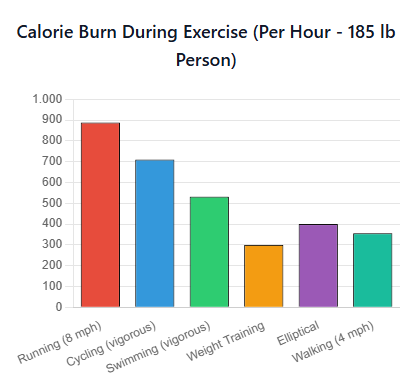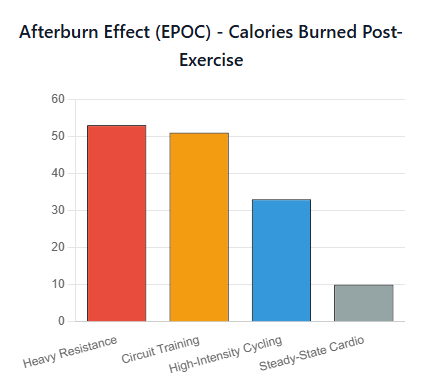The answer: Both cardio and weights are effective for fat loss, but combining both produces the best results. A landmark 2024 study in JAMA Internal Medicine found that participants who combined aerobic and resistance training achieved the greatest reductions in fat mass and waist circumference.
The debate between cardio vs weights for fat loss has dominated fitness discussions for decades.
With over 73% of American adults classified as overweight or obese according to the CDC, understanding the most effective exercise approach for fat loss has never been more critical.
Recent scientific research has revolutionized our understanding of how different exercise modalities affect body composition.
While traditional wisdom suggested cardio was king for fat burning, emerging evidence reveals a more nuanced picture that challenges conventional thinking.
In this comprehensive analysis, we’ll examine the latest scientific evidence, including groundbreaking 2024-2025 research, to determine which approach—or combination—delivers optimal fat loss results.
You’ll discover practical strategies, evidence-based recommendations, and expert insights to maximize your fat loss efforts.
In This Article
The Science Behind Fat Loss: What Actually Works
Fat loss fundamentally occurs when you create a caloric deficit—burning more calories than you consume.
However, the type of exercise you choose significantly impacts how efficiently your body burns fat, preserves muscle mass, and maintains metabolic health.
Understanding Energy Systems
Your body utilizes different energy systems depending on exercise intensity and duration:
- Aerobic System: Uses oxygen to burn both fat and carbohydrates, primarily during low-to-moderate intensity exercise (30-65% of VO₂max)
- Anaerobic System: Relies on stored energy without oxygen, predominantly using carbohydrates during high-intensity exercise (>85% of VO₂max)
- Phosphocreatine System: Provides immediate energy for short, explosive movements lasting 10-15 seconds
Key Research Finding:
A 2024 systematic review in JAMA Network Open analyzing over 400 adults found that aerobic exercise at least 150 minutes per week was associated with clinically significant reductions in waist circumference and body fat measures, regardless of weight loss.
How Cardio Burns Fat: Mechanisms and Benefits
Cardiovascular exercise remains one of the most effective methods for creating the caloric deficit necessary for fat loss.
Here’s why cardio excels at burning fat:
Direct Calorie Burn
Cardio exercises burn more calories per minute than most other activities.
For a 185-pound person, here’s the caloric expenditure for one hour of various cardio activities based on data from the Harvard Health Publishing:
- Running (8 mph): 888 calories
- Cycling (vigorous): 710 calories
- Swimming (vigorous): 532 calories
- Elliptical machine: 400 calories
- Walking (4 mph): 356 calories
Fat Oxidation Zone
During moderate-intensity cardio (60-70% of maximum heart rate), your body preferentially burns fat for fuel.
This “fat-burning zone” maximizes the percentage of calories derived from fat oxidation, though total calorie burn may be lower than high-intensity exercise.
Cardiovascular Health Benefits
Beyond fat loss, regular cardio provides numerous health benefits that support long-term weight management:
- Improved heart health and reduced cardiovascular disease risk
- Enhanced insulin sensitivity and glucose metabolism
- Increased mitochondrial density for better fat oxidation
- Reduced systemic inflammation
- Better sleep quality and stress management
Weight Training for Fat Loss: The Metabolic Advantage
While weight training burns fewer calories during the actual workout compared to cardio, it offers unique advantages for long-term fat loss that make it an essential component of any effective fat loss program.
Muscle Preservation and Growth
The primary advantage of strength training for weight loss lies in its ability to preserve and build lean muscle mass. This is crucial because:
- Muscle tissue burns approximately 6-7 calories per pound per day at rest
- Fat tissue burns only 2-3 calories per pound per day at rest
- Maintaining muscle mass prevents metabolic slowdown during weight loss
- Increased muscle mass improves insulin sensitivity and glucose uptake
Metabolic Boost
Research shows that resistance training can increase your resting metabolic rate (RMR) by 5-9% for up to 72 hours post-workout. This metabolic elevation occurs due to:
- Protein synthesis for muscle repair and growth
- Restoration of energy stores (ATP and creatine phosphate)
- Removal of metabolic byproducts
- Increased oxygen consumption for recovery processes
Research Highlight:
The landmark STRRIDE-AT/RT study, involving 119 overweight adults over 8 months, found that while aerobic training was more effective for reducing total body mass and fat mass, resistance training significantly increased lean body mass and strength without increasing fat mass.
Calorie Burn & Afterburn Effect: Visual Analysis
Understanding the differences in calorie expenditure and post-exercise effects is crucial for making informed decisions about your fat loss strategy. The charts below illustrate key data from our analysis:


Key Insights from the Data:
Immediate Calorie Burn: Cardio activities like running and cycling burn significantly more calories during exercise
Afterburn Advantage: Weight training produces the highest EPOC effect, continuing to burn calories for up to 48 hours
Combined Benefits: The ideal approach leverages both immediate calorie burn from cardio and extended metabolic boost from weights
Cardio vs. Weights: Direct Comparison
| Factor | Cardio | Weight Training | Combined |
|---|---|---|---|
| Calories Burned During Exercise | High (400-800/hour) | Moderate (200-400/hour) | Highest |
| Afterburn Effect (EPOC) | Low-Moderate | High (up to 48 hours) | Highest |
| Muscle Preservation | Poor | Excellent | Excellent |
| Fat Loss Effectiveness | High | Moderate | Highest |
| Time Efficiency | Moderate | High | Lower |
| Metabolic Rate Increase | Temporary | Long-lasting | Optimal |
HIIT vs. Steady-State Cardio: Which Burns More Fat?
The debate between high-intensity interval training (HIIT) and steady-state cardio has intensified with recent research showing surprising results about fat burning efficiency.
HIIT: Maximum Impact in Minimum Time
HIIT alternates between short bursts of high-intensity exercise (85-95% max heart rate) and recovery periods. Benefits include:
- Time efficiency: Achieve similar fat loss results in 50% less time
- Enhanced EPOC: Elevated calorie burn for up to 24 hours post-exercise
- Improved insulin sensitivity: Better glucose metabolism and fat oxidation
- Preserved muscle mass: Less muscle loss compared to steady-state cardio
Steady-State: The Fat-Burning Foundation
Steady-state cardio maintains a consistent intensity (60-70% max heart rate) for extended periods. Advantages include:
- Higher fat oxidation rate: Burns a greater percentage of calories from fat
- Lower stress on the body: Easier recovery and lower injury risk
- Sustainable long-term: Can be performed more frequently
- Improved aerobic capacity: Enhanced cardiovascular endurance
2024 Research Update:
A comprehensive meta-analysis published in Frontiers in Physiology found that both HIIT and steady-state cardio produce comparable fat loss results when total energy expenditure is matched. The key factor is consistency and adherence to your chosen method.
The Afterburn Effect: Why Weights Keep Burning Calories
The afterburn effect, scientifically known as Excess Post-Exercise Oxygen Consumption (EPOC), represents one of the most significant advantages of resistance training for fat loss.
Understanding EPOC
EPOC occurs when your body continues consuming oxygen at elevated rates after exercise to restore physiological processes to baseline levels. This process burns additional calories for hours or even days post-workout.
EPOC by Exercise Type
Research from the University of New Mexico comparing different exercise modalities shows significant differences in EPOC magnitude:
- Heavy resistance training: 53 calories burned in EPOC (highest)
- Circuit training: 51 calories burned in EPOC
- High-intensity cycling: 33 calories burned in EPOC
- Steady-state cardio: 6-15 calories burned in EPOC (lowest)
Maximizing the Afterburn Effect
To optimize EPOC and maximize post-workout calorie burn:
- Use compound movements: Squats, deadlifts, and pull-ups engage multiple muscle groups
- Lift heavy weights: Use 75-85% of your one-rep maximum
- Minimize rest periods: Keep rest between sets to 30-90 seconds
- Include explosive movements: Plyometrics and Olympic lifts enhance EPOC
The Power of Combining Cardio and Weights
The most compelling evidence for optimal fat loss comes from studies examining combined training approaches.
Recent research consistently shows that integrating both cardio and resistance training produces superior results compared to either modality alone.
The 2024 JAMA Breakthrough Study
A landmark 2024 trial published in JAMA Internal Medicine examined various combinations of strength and aerobic training in over 400 adults. Key findings include:
- Greatest fat mass reduction: Combined training group lost 16% more fat than cardio-only
- Largest waist circumference decrease: 2.3 inches average reduction in combined group
- Preserved muscle mass: Only combined training maintained lean body mass during fat loss
- Improved metabolic markers: Better insulin sensitivity and glucose tolerance
Synergistic Benefits
Combining cardio and weights creates synergistic effects that amplify fat loss:
- Enhanced calorie burn: Immediate calories from cardio + extended burn from weights
- Improved body composition: Simultaneous fat loss and muscle preservation
- Better adherence: Variety prevents boredom and plateaus
- Comprehensive fitness: Develops both cardiovascular and muscular systems
Expert Recommendation:
The American College of Sports Medicine recommends combining 150-300 minutes of moderate-intensity cardio per week with 2-3 resistance training sessions for optimal fat loss and health benefits.
Should I Do Cardio or Weights First?
The question of whether to do cardio or weights first has significant implications for fat loss effectiveness.
Recent 2025 research provides clear guidance on optimal exercise sequencing.
Weights First: The Fat Loss Advantage
A 2025 study published in Science Alert found that performing weight training before cardio provides distinct advantages for fat loss:
- Enhanced fat oxidation: Depleted glycogen stores force the body to burn more fat during cardio
- Maintained training intensity: Perform resistance exercises with full energy and proper form
- Greater EPOC effect: Maximized afterburn effect from high-intensity weight training
- Improved strength gains: Better performance when muscles are fresh
Cardio First: When It Makes Sense
Performing cardio before weights may be beneficial when:
- Cardiovascular goals are primary: Training for endurance events
- Warm-up purposes: Light cardio (5-10 minutes) to prepare for lifting
- Time constraints: Prioritizing the most important component of your workout
- Recovery sessions: Low-intensity cardio on rest days from weight training
Separate Sessions: The Optimal Approach
For maximum fat loss results, consider separating cardio and weight training into different sessions or days. This approach allows you to:
- Maintain high intensity for both exercise types
- Optimize recovery between sessions
- Prevent interference effects on strength and muscle gains
- Increase total weekly training volume
Evidence-Based Fat Loss Workout Plans
Based on the latest scientific evidence, here are practical fat loss workout plans designed to maximize results while fitting different schedules and fitness levels.
Beginner Fat Loss Plan (3 Days/Week)
Week Structure:
- Day 1: Full-body resistance training (45 min) + 15 min steady-state cardio
- Day 2: 30 min moderate-intensity cardio
- Day 3: Full-body resistance training (45 min) + 15 min steady-state cardio
- Day 4: Rest or light activity
- Day 5: Full-body resistance training (45 min) + 15 min steady-state cardio
- Days 6-7: Rest or optional 20-30 min walk
Intermediate Fat Loss Plan (4-5 Days/Week)
Week Structure:
- Day 1: Upper body resistance training + 20 min HIIT
- Day 2: 45 min steady-state cardio
- Day 3: Lower body resistance training + 15 min cardio
- Day 4: 30 min HIIT or circuit training
- Day 5: Full-body resistance training
- Days 6-7: Active recovery or optional cardio
Advanced Fat Loss Plan (5-6 Days/Week)
Week Structure:
- Day 1: Push muscles (chest, shoulders, triceps) + 25 min HIIT
- Day 2: Pull muscles (back, biceps) + 30 min steady-state
- Day 3: Legs + 20 min HIIT
- Day 4: 45-60 min moderate cardio
- Day 5: Upper body circuit training
- Day 6: Lower body + core + 20 min cardio
- Day 7: Active recovery or rest
Key Programming Principles
- Progressive overload: Gradually increase weight, reps, or intensity
- Compound movements: Prioritize exercises that work multiple muscle groups
- Adequate recovery: Allow 48-72 hours between training the same muscle groups
- Consistency: Aim for at least 150 minutes of moderate cardio + 2 strength sessions weekly
Common Fat Loss Mistakes to Avoid
Understanding what not to do is just as important as knowing the right approach.
Here are the most common mistakes that sabotage fat loss efforts:
Exercise-Related Mistakes
- Cardio-only approach: Leads to muscle loss and metabolic slowdown
- Excessive steady-state cardio: Can increase cortisol and hinder recovery
- Neglecting progressive overload: Muscles adapt quickly without increasing challenges
- Poor exercise form: Reduces effectiveness and increases injury risk
- Inconsistent training: Sporadic workouts prevent meaningful adaptations
Programming Mistakes
- Overtraining: Excessive volume without adequate recovery
- Ignoring compound movements: Focusing only on isolation exercises
- Inadequate intensity: Staying in comfort zone without challenging the body
- Poor exercise selection: Choosing ineffective exercises for fat loss goals
Critical Warning:
Extreme calorie restriction combined with excessive cardio can lead to metabolic damage, muscle loss, and rebound weight gain. Always maintain a moderate caloric deficit (300-500 calories below maintenance) for sustainable fat loss.
Frequently Asked Questions
How much cardio should I do to lose weight?
The American College of Sports Medicine recommends 150-300 minutes of moderate-intensity cardio per week for weight loss. For faster results, aim for 250+ minutes weekly combined with resistance training.
Can I lose fat with weights alone?
Yes, but it’s less efficient than combining weights with cardio. Weight training preserves muscle and boosts metabolism, but cardio burns more calories during exercise, making the combination most effective.
Is HIIT better than steady-state cardio for fat loss?
Both are effective when total energy expenditure is matched. HIIT is more time-efficient and preserves muscle better, while steady-state cardio burns a higher percentage of fat and is easier to recover from.
Should I do cardio every day for fat loss?
Daily cardio isn’t necessary and may lead to overtraining. Aim for 4-6 cardio sessions per week, varying intensity and allowing rest days for recovery and muscle growth.
What’s the best exercise for weight loss?
There’s no single “best” exercise. The most effective approach combines compound resistance exercises (squats, deadlifts, pull-ups) with both HIIT and steady-state cardio for comprehensive fat loss.
How long should I wait between cardio and weights?
If doing both in one session, perform weights first for fat loss benefits. If separating sessions, allow at least 6-8 hours between high-intensity workouts for optimal recovery.
Can I build muscle and lose fat simultaneously?
Yes, especially for beginners or those returning to exercise. Combine resistance training with moderate cardio and maintain adequate protein intake (0.8-1g per pound of body weight).
Why am I not losing weight despite exercising regularly?
Weight loss requires a caloric deficit. You may be gaining muscle while losing fat (body recomposition), eating more calories than you burn, or experiencing water retention. Focus on body composition changes, not just scale weight.
Final Recommendations: Your Path to Optimal Fat Loss
The evidence is clear: combining cardio and weights produces superior fat loss results compared to either approach alone.
The 2024 research consistently demonstrates that integrated training programs maximize fat loss while preserving lean muscle mass and boosting metabolic health.
Key Takeaways
- Cardio excels at immediate calorie burn and cardiovascular health improvements
- Weight training provides long-term metabolic benefits through muscle preservation and EPOC
- Combined training delivers the best of both worlds for comprehensive fat loss
- Exercise order matters: Perform weights before cardio for enhanced fat oxidation
- Consistency trumps perfection: Regular moderate exercise beats sporadic intense sessions
Your Action Plan
- Start with your current fitness level and gradually progress
- Aim for 150+ minutes of cardio weekly plus 2-3 resistance training sessions
- Prioritize compound movements in your strength training routine
- Include both HIIT and steady-state cardio for variety and adherence
- Monitor progress through body composition, not just scale weight
- Maintain a moderate caloric deficit through diet and exercise
Ready to Start Your Fat Loss Journey?
Remember, the best exercise program is the one you can stick to consistently. Start with manageable goals, track your progress, and adjust your approach based on results and preferences.
Take action today: Choose one of the workout plans above and commit to following it for the next 4 weeks. Your future self will thank you for starting now.

